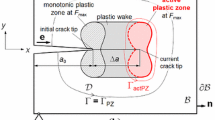Abstract
Elastic-plastic finite element simulations of growing plane stress fatigue cracks are used to study standard fatigue threshold test schemes. Load reduction operations are shown to cause artificial increases in crack closure. The crack still continuously ‘unzips’ during loading, so that the crack surfaces immediately behind the current crack tip are the last to separate. The increases in crack closure are clearly associated with increases in residual displacements in the wake of the crack generated earlier in the load history, when applied stresses were greater. The nondimensional nature of the finite element analysis shows that the dimensional form of the current ASTM standard for fatigue threshold testing admits possible effects of specimen size and applied stress level on closure behavior and hence on the apparent threshold. The current ASTM standard does not appear to be entirely consistent with a continuum mechanics description of plasticity-induced crack closure. The current standard may still give acceptable results when specimens are relatively small and relatively thick and initial applied stresses are a relatively small fraction of the yield stress.
Similar content being viewed by others
References
D. Taylor, International Journal of Fatigue 10 (1988) 67–79.
D. Taylor, A Compendium of Fatigue Thresholds and Growth Rates, EMAS (1985).
ASTM E647-88a, in Annual Book of ASTM Standards, Vol. 03.01 (1989) 646–666.
A. Saxena, S.J. HudakJr., J.K. Donald and D.W. Schmidt, Journal of Testing and Evaluation 6 (1978) 167–174.
H. Doker, V. Bachmann and G. Marci, in Proceedings International Conference on Fatigue Thresholds, Stockholm, Sweden, EMAS (1981) 45–57.
W.A. Herman, R.W. Hertzberg, C.H. Newton and R. Jaccard, in Fatigue 87, Proceedings 3rd International Conference on Fatigue and Fatigue Thresholds, Charlottesville, Virginia, Vol. 2 (1987) 819–828.
W.A. Herman, R.W. Hertzberg and R. Jaccard, Fatigue and Fracture of Engineering Materials and Structures 11 (1988) 303–320.
A.J. Cadman, R. Brook and C.E. Nicholson, in Proceedings International Conference on Fatigue Thresholds, Stockholm, Sweden, EMAS (1981) 59–75.
E.K. Priddle, Fatigue and Fracture of Engineering Materials and Structures 12 (1989) 333–345.
M.N. James and J.F. Knott, Fatigue and Fracture of Engineering Materials and Structures 8 (1985) 177–191.
J.C. Newman, Jr., in Behavior of Short Cracks in Airframe Components, AGARD Conference Proceedings No. 328 (1982) 6.1–6.26.
A. Ohta and E. Sasaki, Engineering Fracture Mechanics 9 (1977) 655–662.
A. Ohta, M. Kosuge and E. Sasaki, International Journal of Fracture 14 (1978) 251–264.
K. Minakawa, J.C. NewmanJr. and A.J. McEvily, Fatigue of Engineering Materials and Structures 6 (1983) 359–365.
N.A. Fleck, An Investigation of Fatigue Crack Closure, CUED/C-MATS/TR.104, Cambridge University Engineering Department (1984).
K. Ohji, K. Ogura and Y. Ohkubo, International Journal of Fracture 10 (1974), RCR 123–124.
K. Ohji, K. Ogura and Y. Ohkubo, Engineering Fracture Mechanics 7 (1975) 457–464.
J.C. Newman, Jr., ‘Finite Element Analysis of Fatigue Crack Propagation—Including the Effects of Crack Closure,’ Ph.D. thesis, Virginia Polytechnic Institute and State University, Blacksburg, Virginia (1974).
J.C. Newman, Jr., in Mechanics of Crack Growth, ASTM STP 590 (1976) 281–301.
R.C. McClung and H. Sehitoglu, Engineering Fracture Mechanics 33 (1989) 237–252.
R.C. McClung and H. Sehitoglu, Engineering Fracture Mechanics 33 (1989) 253–272.
N.A. Fleck and R.A. Smith, International Journal of Fatigue 4 (1982) 157–160.
R.C. McClung, B.H. Thacker and S. Roy, International Journal of Fracture 50 (1991) 27–49.
R.C. McClung and D.L. Davidson, Engineering Fracture Mechanics 39 (1991) 113–130.
D.L. Davidson, in Mechanics of Fatigue Crack Closure, ASTM STP 982 (1988) 44–61.
S.J. Hudak, Jr. and D.L. Davidson, in Mechanics of Fatigue Crack Closure, ASTM STP 982 (1988) 121–138.
Author information
Authors and Affiliations
Rights and permissions
About this article
Cite this article
McClung, R.C. Finite element modeling of crack closure during simulated fatigue threshold testing. Int J Fract 52, 145–157 (1991). https://doi.org/10.1007/BF00032374
Received:
Accepted:
Issue Date:
DOI: https://doi.org/10.1007/BF00032374




